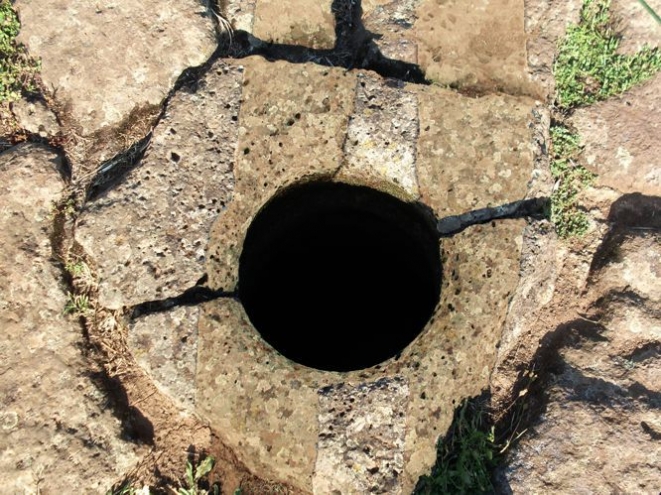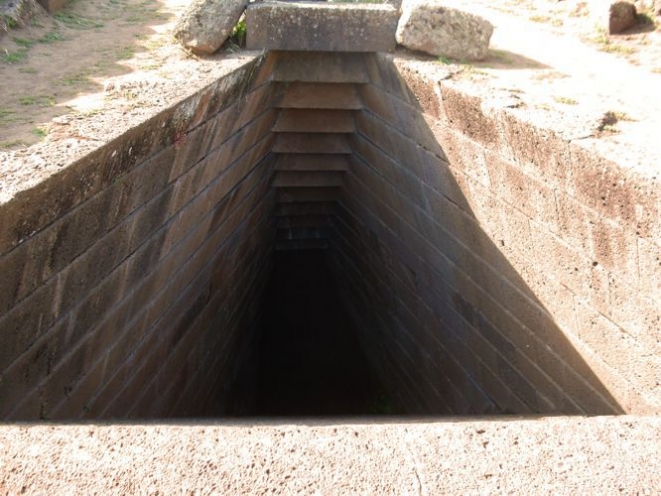The moon in the well
The sacred well of Santa Cristina. The most innovative moon observatory of ancient times
The Sardinian sacred wells are the places of cult that date back to the nuragic epoch. Located above all in the hinterland, such as the nuraghes, they are characterized by an excellent virtuosity in the realization. Their building is inspired exactly to nuraghes and their purpose is mainly religious.
It is useless to stress the basic value that water had for the nuragic population. It was an important element such that it was venerated and the sacred well fulfills completely also to this purpose. The best example of sacred well in Sardinia is that of Santa Cristina, in Paulilatino in the Province of Oristano, dated back to the Eleventh Century Before Christ.
In the religious viewpoint, it is evident the very strong symbolism that marked this kind of building and the most correct interpretation that can be done today is that according to which the well represents metaphorically the uterus of the "mother Earth", through the amniotic fluid reproduced exactly by water. The staircase has a double purpose.
Indeed, it represents the passage from the dark to the light through the birth and from the light to the dark through the death. But, there is something more. The sacred well of Santa Cristina is an unique architectural magnificence, a shrine that, thanks to its sizes, the technical perfection of the walls, the attention of the drawing, geometric perfections and stylish and optical qualities, does not have equals in the whole Mediterranean basin.

The true greatness of this monument, contrary to that was thought until a short time ago, is that it is "the most advanced moon observatory in ancient times". This statement was given by an important French-Polish archaeo-astronomer, Arnold Lebeuf, who studied, in an accurate way, this monument, writing then an interesting book with this title: "The well of Santa Cristina, a moon observatory".
The statement by this academic removes always more the old and rueful myth according to which nuragic people represented a boorish and rough population of ignorant shepherds, proving instead their special architectural, geometric and above all astronomical knowledges.
Omitting the architectural quality of the isodomum well, with finely decorated basalt ashlars – by virtue of their grade, they are situated such that they create some prominent concentric wires, respecting the balancing laws of the weight applied to the triangle – and the majestic staircase, among the biggest that are known, what astonishes is its incredible orientation. The site, based on this statement, it is not a simple place of cult, but an authentic scientific tool.
A true observatory. Indeed, here, we are not in the face of a terrestrial orientation – it does not have nothing to do with the location of other temples, nuraghes or other archaeological sites – but we are in the face of something that is extraordinary that shows exactly astronomy. It represents something that is difficult to understand and to explain. Each 18 years and six months, the moon, passing through the meridian, mirrors on the surface of the well. This happens only when the star reaches its greater height, and this happens during the northern greater lunistice.
From the hole of the underground tholos", in that exact instant, it penetrates the ray of the moon that mirrors in the water. Some archaeologists tried to invalidate, but without great results, the Lebeuf’s deductions, who instead was able to restate, with determination, the validity of his theory and to stress the magnificence of the monument that represents a majestic astronomical and technological tool, able to allow to do some incredibly accurate remarks of the moon motions, such that it allows who used it to predict eclipses.
Some years ago, in a period of advancement of his analysis, the academic revealed some stunning data. If the well was built approximately in 1000 Before Christ and if we referred to the astronomical data that characterized the moon in that epoch, the precision of the orientation would be equal about to three minutes, namely one-twentieth of the degree.

If we consider that now we are in a phase during which the height of the moon, at the northern greater lunistice, decreases of two minutes each 300 years, it is easy to infer that the orientation shows an amazing precision. The builders had a nearly absolute, incredible and astonishing rigor, because there is an approximation of an only degree and that would guarantee anyway the astronomical meaning of the well.
Another significant element that confirms this theory is the presence of a row of stones different compared to others. All the rows have the same size; instead, in the middle of the dome, there is a row that is the highest. So, Lebeuf asserts that this row indicates, through extreme precision, the middle lunistice. So we can only ask ourselves, how it was possible that a population was able to build such a masterpiece of engineering.
Such a drawing was difficult to realize in conjunction with the observations of the stars, supposing that there was such a strengthened astronomical knowledge. At the bottom, in addition to that, there was a clear planning of the whole work, too, in the builders’ mind and before beginning digging the well.
We are not presumptuous if we think that in the middle of Sardinia, in the Eleventh Century Before Christ, there was one of the milestones for the history of the whole scientific research and, considered individually, the majestic contribution of Lebeuf was able to open a new way of interpretation, narrowest but most charming and still to be traversed, about a population that will not finish amazing.